Top ratings
Get free trial access now Try first, then study!
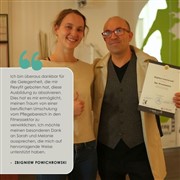
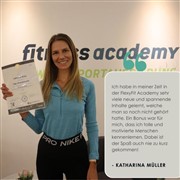
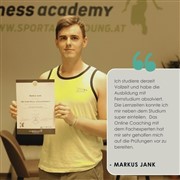
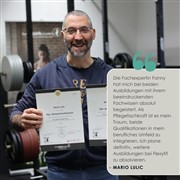
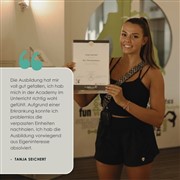


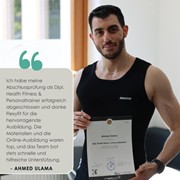

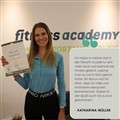
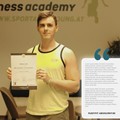
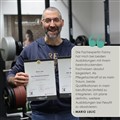



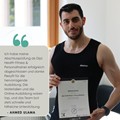

€ 1.890,- | Classroom Courses
» Our Course Packages
Important informations
Recognized & Certified
Our graduates, partners & friends say
Our team will be happy to advise you at any time by phone, chat or in person
Our training in classical massage is aimed at fitness and personal trainers, masseurs, physiotherapists as well as anyone interested (career changers) who would like to expand their knowledge and skills.
The course offers a comprehensive introduction to the techniques and principles of classical massage. This traditional massage method aims to relieve tension, promote blood circulation and improve general well-being. In our courses, participants learn the theoretical basics such as anatomy and physiology as well as the practical applications of various massage strokes and techniques.
Incidentally, this training can be optimally supplemented with other courses such as certified trigger point masseur, certified sports masseur or certified foot reflexology masseur.
Legal note: The practical application of the knowledge acquired in this course requires an existing professional license, for example as a commercial masseur or therapeutic masseur. If the course is taken as an individual course, the knowledge acquired may only be used for private purposes, in the context of family and neighborhood assistance or within an employment relationship. The training courses offered serve exclusively to impart knowledge and skills for use on healthy people. No medical therapies are taught or practiced. The content of the events does not constitute medical training and is no substitute for medical or therapeutic treatment. Participants are responsible for ensuring that the knowledge and skills acquired are applied in accordance with the applicable legal provisions.
Note on self-employment as a masseur: The self-employed practice of the profession of masseur is regulated in the Trade Regulation Act for the regulated trade of masseurs and masseuses. For an individual trade, limited to classical massage (§19 GewO), you can start working in your own practice after completing the massage training, a 6-month practice and a successful work sample. Detailed information on the trade regulations and the requirements can be obtained directly from your local Chamber of Commerce.
Extent of learning
422 E
EQF level
The training is based on EQF level 4 »
Course start
Possible immediately
Learning variant
Classroom Courses
Available
Languages

| 03-01-2026 | € 1.890,-
| 03-01-2026 | € 1.890,-
| 03-01-2026 | € 1.890,-
| 10-01-2026 | € 1.890,-

Training in classical massage provides a comprehensive introduction to the art of massage, which has been used for centuries to promote well-being and health. This course not only teaches the theoretical principles, but also places great emphasis on the practical skills required for the professional practice of classical massage. It is aimed at people who wish to pursue a career in the field of massage and body therapy or expand their knowledge and skills in this area.
You will begin with an introduction to the history and development of massage, learn the basic techniques such as effleurage, petrissage, friction, tapotement and vibrationand deepen your knowledge by combining and adapting these techniques to different areas of the body. Practical exercises and case studies are an essential part of the training in order to consolidate the techniques you have learned and apply them in realistic scenarios.
You will also be trained in communication and client care skills to ensure professional and empathetic care for your clients. You will learn how to take a medical history, create and customize massage plans and advise clients on self-care and aftercare. Hygiene guidelines and ethical standards are also an important part of the training to ensure the safety and well-being of clients.
Our certificates are issued in different versions. On request, you can receive our certificate in several languages (DE, EN, ES), with country-specific information and with or without printed grades.
These variants are all available to download online free of charge. You will also receive a certificate of your choice printed on special embossed paper.
The following certificate is awarded (in several languages DE, EN, ES):
"Diploma Classical Masseur"
We will be happy to help you by phone, e-mail or chat.
Extent of learning
200
Massage expertise
182
Presence | Self-study
5
Literature research
30
Practical realization
5
Additional tasks & examinations
Our training courses are generally eligible for funding. The relevant funding body will decide whether you are eligible for funding.
We will be happy to support you in compiling all the necessary course information you need for your funding application.
Of course, we will be on hand to advise you throughout the entire process and support you from the initial inquiry to the submission of your application. Contact us - we will make sure that you are as well prepared as possible!
Show all chapters of the subjects

We educate the best trainers in the fitness branch. From start to finish of the education - and beyond!- we support and guide our students.
Functional anatomy is a foundation necessary for all trainers in exercise, fitness and sports. This subject provides a comprehensive introduction to the anatomy of the human body and a wellspring of important knowledge.
The course is constructed to present the information in an interesting and comprehensible manner and features different learning approaches appropriate for Fitness and Personal Trainers.
The goal is, to understand the relationship between movement patterns, the human body and relevant anatomical terminology.

The subject"Professional Ethics and Professionalism" in the basic massage skills module teaches essential ethical principles and rules of conduct that are essential for a professional massage practice. The course begins with an introduction to professional ethics, covering in detail the ethical principles and their importance in practice. Participants will learn how to deal with ethical dilemmas and make decisions that are in the best interest of their clients.
Another important aspect is dealing with clients, data protection and confidentiality. The training covers guidelines for dealing with clients in a professional manner, adhering to data protection guidelines and maintaining confidentiality. It emphasizes the importance of trust and respect in the relationship with clients and how these values can be upheld through professional practice.
In addition, fundamentals of professional demeanor and effective communication strategies are taught. Participants will learn how to maintain a professional appearance and build a successful relationship with their clients. Communication strategies for dealing with clients, including techniques for conflict management and resolution, are also covered. This subject emphasizes the development of a professional attitude and the ability to act appropriately and ethically in a variety of situations.

The"Ergonomics and self-care" subject in the basic massage skills module focuses on correct posture and ergonomics for therapists to avoid strain and injury. The importance of ergonomics in massage practice is emphasized and techniques for avoiding strain are taught. Practical exercises to improve posture are also a key part of this module.
In addition, self-care and recovery techniques for therapists are taught. The importance of self-care is emphasized as it is crucial for the long-term health and performance of therapists. Self-massage techniques and relaxation exercises are introduced to help therapists take care of themselves. Strategies for recovery and injury prevention are also covered to ensure sustainable practice and protect therapists' health.


The subject"Hygiene" in the basic massage competence module deals comprehensively with the essential hygiene standards and safety measures in massage practice.
It begins with the importance of hygiene in massage practice, followed by detailed hygiene guidelines and their implementation. Participants are given practical tips for maintaining hygiene to ensure a safe and clean working environment.
Another focus is on safety measures. Safety precautions for everyday practice are presented here, including specific protective measures for massage therapists and clients.

The subject"Client management and practice management" in the basic massage skills module provides essential knowledge for the successful operation of a massage practice. It begins with building and maintaining a client file, emphasizing the importance of a well-maintained client file. Participants will learn techniques to effectively manage client data and comply with data protection and legal requirements.
Another focus is the design and maintenance of the working environment. Here, participants learn how to design the massage area in the best possible way to create a welcoming atmosphere. High standards of hygiene and cleanliness are taught, and the need for regular maintenance and care of massage rooms and equipment is emphasized.
The third area of the subject focuses on marketing and customer retention. The basics of marketing for massage practices are explained and participants develop strategies for attracting and retaining customers. The use of social media and other digital marketing tools to increase the reach and awareness of the practice will also be addressed.
This subject provides comprehensive training in client management, practice management and marketing to ensure the successful operation and growth of your massage practice.

In the "Massage Techniques and Practices" subject, basic massage techniques are taught using online learning videos. These videos provide participants with a comprehensive introduction to the various techniques and allow them to familiarize themselves with the basics at their own pace. In the practical module "Massage techniques and hygiene", these techniques are then intensively practiced and deepened on site.
Participants have the opportunity to familiarize themselves with the various massage techniques through the instructional videos and learn them step by step. This prepares them optimally for the practical exercises. They can apply what they have learned on site and improve it with direct guidance from experienced instructors and trainers.

The "Pathology" subject in the basic massage skills module provides essential knowledge that is essential for safe and effective massage practice.
The basics of pathology and common conditions are covered, including:
In addition, participants will learn about the indications and contraindications for massage:
Another important aspect is recognizing and dealing with medical emergencies during a massage, including

A working understanding of human physiology and therefore the relationships between the various functions of the human body is crucial for anyone working in the exercise and fitness field. It is a requisite knowledge for the sufficient practice of their profession.
This course makes the relationships within the human organism graspable for everyone. Take a deep-dive into the human body and learn the functions of our organism for your new profession in fitness.
In this subject you will get a close look at energy metabolism needed for muscle activation, the circulatory system and the pulmonary system.
Any high quality education in fitness and exercise begins with the foundations of anatomy and physiology.

The subject"Psychological basics" in the basic massage skills module provides essential knowledge of psychology, which is crucial for dealing professionally with clients in massage practice.
Participants gain basic knowledge of psychology, particularly in dealing with stress, relaxation and emotional reactions. The introduction to the psychological aspects of massage helps participants to understand how to deal with stress and emotional reactions of clients. Techniques to promote relaxation and well-being are also taught.
Another focus is on communication skills and building a therapeutic relationship. The importance of communication in massage practice is emphasized and how to build and maintain a therapeutic relationship is taught. Empathy and maintaining a professional distance when dealing with clients play an important role.
This subject provides in-depth training in the areas of psychological knowledge and communication skills to create a trusting and supportive environment for clients and promote their well-being.
Show all chapters of the subjects

In addition to the practical application of these techniques, the important hygiene guidelines are also discussed. This includes
Cleaning: The correct cleaning of the workplace and the materials used.
Disinfection: Effective disinfection methods to prevent the spread of pathogens.
Personal hygiene: The importance of the masseur's personal hygiene to ensure a hygienic environment for clients.
Show all chapters of the subjects

The subject "Findings & anamnesis" teaches essential skills for dealing with clients. It begins with interviewing and anamnesis, covering methods of interviewing and conducting a detailed anamnesis. Another focus is on creating a massage plan, which includes planning and documenting massages and adapting the plan based on client feedback.
In client care and aftercare, participants learn how to advise clients on self-care and prevention and provide aftercare and further treatment recommendations. This subject is crucial for providing professional and compassionate care to clients.


The subject "Fundamentals & Principles of Massage" teaches basic knowledge and skills in classic massage. At the beginning, the participants are welcomed, the course objectives and schedule are explained and the lecturers and participants are introduced.
One focus of the subject is on the history and development of massage. The historical development, cultural influences and the evolution of techniques are covered. Participants learn how massage techniques have developed from their origins to the present day and which cultural influences have played a role.
Another central point is the hygiene guidelines and ethical standards. Participants will learn which hygiene regulations and practices must be observed during massage practice and which professional ethics and rules of conduct apply to massage therapists. The handling of personal and medical information is also discussed in order to protect the privacy of clients and ensure high-quality care.


In this practice-oriented course, you will learn how to professionally examine and treat your clients - from head to toe. You will develop a deep understanding of the anatomy and function of the back, neck, shoulders, arms, hands and thorax.
You will practise the systematic assessment of findings (medical history, inspection, palpation and functional testing) in order to reliably identify muscular imbalances, blockages and contraindications. On this basis, you apply effective massage techniques that not only relax, but also alleviate specific complaints.
Whether classic grips, functional massages, friction or special techniques for tissue mobilization - you will learn to treat each region individually and choose the right measures. Ideal for anyone who works professionally in the field of sport, health or wellness or would like to expand their knowledge.

In this course module, you will learn how to provide a high-quality massage with the right preparation and technique. From the optimal design of the massage room and the hygienic and ergonomic preparation of your hands to the selection and adjustment of the massage table - here you will learn the basics for a safe and effective massage procedure.
You will practise keeping your hands fit and resilient with warm-up, stretching and strengthening exercises and learn how to optimize positioning for different client needs. You will also learn how to deal professionally with special challenges such as sensitive skin, thick body hair or ticklish customers.
This subject is ideal for anyone who values quality, precision and health - both for the client and for themselves as a therapist.
Available course variations
There are a variety of funding options for training courses at the Flexyfit Massage Academy. State-specific and EU funding as well as tax-related options form the basis for this.
However, we would like to point out that the respective funding body is solely responsible for deciding on the allocation or amount of funding.
We will be happy to help you find a suitable funding body and compile all the course information you need for a funding application. You must submit the application itself to the funding bodies.
Depending on the funding institution, the training costs are either paid directly after the funding application has been confirmed (e.g. AMS) or reimbursed in full or in part after successful completion of the training (e.g. waff). Please contact the funding institutions yourself to find out how the funding works.
Yes, the majority of our courses are suitable for educational leave.
If you want to continue your education without terminating your employment, you can arrange educational leave with your employer. This means you will be released from work for the duration of your training.
Plan your educational leave with us now! We will be happy to clarify your individual training requirements with you in a personal, non-binding consultation.
You can take your educational leave for a maximum of 1 year within 4 years - there are 3 options:
It is important that your employer agrees to you taking educational leave. You must provide evidence of the training plans issued by us to the extent of 20 hours per week in the case of full-time educational leave, or at least 10 hours in the case of part-time educational leave.
You must regularly provide evidence of the progress of your training. For example, in the form of examinations or confirmation of attendance, which you will receive from us.
Our training content forms the basis for the theoretical and practical parts of the individual certificate of competence at the Chamber of Commerce.
Graduates of the "classical massage" course have the opportunity to work as an employee in the field of classical massage . In addition, they can register the restricted trade for practicing classical massage. If they meet the required criteria, they can then expand their trade to become a commercial masseur and work independently as well as open their own massage institute.
The certificate of qualification can be obtained in consultation with the Chamber of Commerce (WKO) and after appropriate individual massage practice, which was completed after completing the certificate program.
Expand your skills and open up new career prospects through further specializations. Deepen your knowledge in specific areas such as foot reflexology, connective tissue massage, sports massage or hot stone massage. These additional qualifications enable you to offer a broader range of therapies and thus respond even more specifically to the individual needs of your clients.
Our numerous workshops offer you the opportunity to learn new techniques in a practical and intensive way and to continuously expand your expertise. You will benefit from the experience of our qualified instructors and gain valuable insights into specialized massage techniques.
Take the opportunity to further your education and take your career as a massage therapist to the next level. By expanding your specialist knowledge and skills , you will not only increase your professional opportunities, but also your attractiveness on the job market. Take the next step and be inspired by our wide range of training opportunities.
Training in classical massage provides a comprehensive introduction to the art of massage, which has been used for centuries to promote well-being and health. This course not only teaches the theoretical principles, but also places great emphasis on the practical skills required for the professional practice of classical massage. It is aimed at people who wish to pursue a career in the field of massage and body therapy or expand their knowledge and skills in this area.
You will begin with an introduction to the history and development of massage, learn the basic techniques such as effleurage, petrissage, friction, tapotement and vibrationand deepen your knowledge by combining and adapting these techniques to different areas of the body. Practical exercises and case studies are an essential part of the training in order to consolidate the techniques you have learned and apply them in realistic scenarios.
You will also be trained in communication and client care skills to ensure professional and empathetic care for your clients. You will learn how to take a medical history, create and customize massage plans and advise clients on self-care and aftercare. Hygiene guidelines and ethical standards are also an important part of the training to ensure the safety and well-being of clients.
Our certificates are issued in different versions. On request, you can receive our certificate in several languages (DE, EN, ES), with country-specific information and with or without printed grades.
These variants are all available to download online free of charge. You will also receive a certificate of your choice printed on special embossed paper.
The following certificate is awarded (in several languages DE, EN, ES):
"Diploma Classical Masseur"
We will be happy to help you by phone, e-mail or chat.
Extent of learning
200
Massage expertise
182
Presence | Self-study
5
Literature research
30
Practical realization
5
Additional tasks & examinations
Our training courses are generally eligible for funding. The relevant funding body will decide whether you are eligible for funding.
We will be happy to support you in compiling all the necessary course information you need for your funding application.
Of course, we will be on hand to advise you throughout the entire process and support you from the initial inquiry to the submission of your application. Contact us - we will make sure that you are as well prepared as possible!
Show all chapters of the subjects

We educate the best trainers in the fitness branch. From start to finish of the education - and beyond!- we support and guide our students.
Functional anatomy is a foundation necessary for all trainers in exercise, fitness and sports. This subject provides a comprehensive introduction to the anatomy of the human body and a wellspring of important knowledge.
The course is constructed to present the information in an interesting and comprehensible manner and features different learning approaches appropriate for Fitness and Personal Trainers.
The goal is, to understand the relationship between movement patterns, the human body and relevant anatomical terminology.

The subject"Professional Ethics and Professionalism" in the basic massage skills module teaches essential ethical principles and rules of conduct that are essential for a professional massage practice. The course begins with an introduction to professional ethics, covering in detail the ethical principles and their importance in practice. Participants will learn how to deal with ethical dilemmas and make decisions that are in the best interest of their clients.
Another important aspect is dealing with clients, data protection and confidentiality. The training covers guidelines for dealing with clients in a professional manner, adhering to data protection guidelines and maintaining confidentiality. It emphasizes the importance of trust and respect in the relationship with clients and how these values can be upheld through professional practice.
In addition, fundamentals of professional demeanor and effective communication strategies are taught. Participants will learn how to maintain a professional appearance and build a successful relationship with their clients. Communication strategies for dealing with clients, including techniques for conflict management and resolution, are also covered. This subject emphasizes the development of a professional attitude and the ability to act appropriately and ethically in a variety of situations.

The"Ergonomics and self-care" subject in the basic massage skills module focuses on correct posture and ergonomics for therapists to avoid strain and injury. The importance of ergonomics in massage practice is emphasized and techniques for avoiding strain are taught. Practical exercises to improve posture are also a key part of this module.
In addition, self-care and recovery techniques for therapists are taught. The importance of self-care is emphasized as it is crucial for the long-term health and performance of therapists. Self-massage techniques and relaxation exercises are introduced to help therapists take care of themselves. Strategies for recovery and injury prevention are also covered to ensure sustainable practice and protect therapists' health.


The subject"Hygiene" in the basic massage competence module deals comprehensively with the essential hygiene standards and safety measures in massage practice.
It begins with the importance of hygiene in massage practice, followed by detailed hygiene guidelines and their implementation. Participants are given practical tips for maintaining hygiene to ensure a safe and clean working environment.
Another focus is on safety measures. Safety precautions for everyday practice are presented here, including specific protective measures for massage therapists and clients.

The subject"Client management and practice management" in the basic massage skills module provides essential knowledge for the successful operation of a massage practice. It begins with building and maintaining a client file, emphasizing the importance of a well-maintained client file. Participants will learn techniques to effectively manage client data and comply with data protection and legal requirements.
Another focus is the design and maintenance of the working environment. Here, participants learn how to design the massage area in the best possible way to create a welcoming atmosphere. High standards of hygiene and cleanliness are taught, and the need for regular maintenance and care of massage rooms and equipment is emphasized.
The third area of the subject focuses on marketing and customer retention. The basics of marketing for massage practices are explained and participants develop strategies for attracting and retaining customers. The use of social media and other digital marketing tools to increase the reach and awareness of the practice will also be addressed.
This subject provides comprehensive training in client management, practice management and marketing to ensure the successful operation and growth of your massage practice.

In the "Massage Techniques and Practices" subject, basic massage techniques are taught using online learning videos. These videos provide participants with a comprehensive introduction to the various techniques and allow them to familiarize themselves with the basics at their own pace. In the practical module "Massage techniques and hygiene", these techniques are then intensively practiced and deepened on site.
Participants have the opportunity to familiarize themselves with the various massage techniques through the instructional videos and learn them step by step. This prepares them optimally for the practical exercises. They can apply what they have learned on site and improve it with direct guidance from experienced instructors and trainers.

The "Pathology" subject in the basic massage skills module provides essential knowledge that is essential for safe and effective massage practice.
The basics of pathology and common conditions are covered, including:
In addition, participants will learn about the indications and contraindications for massage:
Another important aspect is recognizing and dealing with medical emergencies during a massage, including

A working understanding of human physiology and therefore the relationships between the various functions of the human body is crucial for anyone working in the exercise and fitness field. It is a requisite knowledge for the sufficient practice of their profession.
This course makes the relationships within the human organism graspable for everyone. Take a deep-dive into the human body and learn the functions of our organism for your new profession in fitness.
In this subject you will get a close look at energy metabolism needed for muscle activation, the circulatory system and the pulmonary system.
Any high quality education in fitness and exercise begins with the foundations of anatomy and physiology.

The subject"Psychological basics" in the basic massage skills module provides essential knowledge of psychology, which is crucial for dealing professionally with clients in massage practice.
Participants gain basic knowledge of psychology, particularly in dealing with stress, relaxation and emotional reactions. The introduction to the psychological aspects of massage helps participants to understand how to deal with stress and emotional reactions of clients. Techniques to promote relaxation and well-being are also taught.
Another focus is on communication skills and building a therapeutic relationship. The importance of communication in massage practice is emphasized and how to build and maintain a therapeutic relationship is taught. Empathy and maintaining a professional distance when dealing with clients play an important role.
This subject provides in-depth training in the areas of psychological knowledge and communication skills to create a trusting and supportive environment for clients and promote their well-being.
Show all chapters of the subjects

In addition to the practical application of these techniques, the important hygiene guidelines are also discussed. This includes
Cleaning: The correct cleaning of the workplace and the materials used.
Disinfection: Effective disinfection methods to prevent the spread of pathogens.
Personal hygiene: The importance of the masseur's personal hygiene to ensure a hygienic environment for clients.
Show all chapters of the subjects

The subject "Findings & anamnesis" teaches essential skills for dealing with clients. It begins with interviewing and anamnesis, covering methods of interviewing and conducting a detailed anamnesis. Another focus is on creating a massage plan, which includes planning and documenting massages and adapting the plan based on client feedback.
In client care and aftercare, participants learn how to advise clients on self-care and prevention and provide aftercare and further treatment recommendations. This subject is crucial for providing professional and compassionate care to clients.


The subject "Fundamentals & Principles of Massage" teaches basic knowledge and skills in classic massage. At the beginning, the participants are welcomed, the course objectives and schedule are explained and the lecturers and participants are introduced.
One focus of the subject is on the history and development of massage. The historical development, cultural influences and the evolution of techniques are covered. Participants learn how massage techniques have developed from their origins to the present day and which cultural influences have played a role.
Another central point is the hygiene guidelines and ethical standards. Participants will learn which hygiene regulations and practices must be observed during massage practice and which professional ethics and rules of conduct apply to massage therapists. The handling of personal and medical information is also discussed in order to protect the privacy of clients and ensure high-quality care.


In this practice-oriented course, you will learn how to professionally examine and treat your clients - from head to toe. You will develop a deep understanding of the anatomy and function of the back, neck, shoulders, arms, hands and thorax.
You will practise the systematic assessment of findings (medical history, inspection, palpation and functional testing) in order to reliably identify muscular imbalances, blockages and contraindications. On this basis, you apply effective massage techniques that not only relax, but also alleviate specific complaints.
Whether classic grips, functional massages, friction or special techniques for tissue mobilization - you will learn to treat each region individually and choose the right measures. Ideal for anyone who works professionally in the field of sport, health or wellness or would like to expand their knowledge.

In this course module, you will learn how to provide a high-quality massage with the right preparation and technique. From the optimal design of the massage room and the hygienic and ergonomic preparation of your hands to the selection and adjustment of the massage table - here you will learn the basics for a safe and effective massage procedure.
You will practise keeping your hands fit and resilient with warm-up, stretching and strengthening exercises and learn how to optimize positioning for different client needs. You will also learn how to deal professionally with special challenges such as sensitive skin, thick body hair or ticklish customers.
This subject is ideal for anyone who values quality, precision and health - both for the client and for themselves as a therapist.
Available course variations
There are a variety of funding options for training courses at the Flexyfit Massage Academy. State-specific and EU funding as well as tax-related options form the basis for this.
However, we would like to point out that the respective funding body is solely responsible for deciding on the allocation or amount of funding.
We will be happy to help you find a suitable funding body and compile all the course information you need for a funding application. You must submit the application itself to the funding bodies.
Depending on the funding institution, the training costs are either paid directly after the funding application has been confirmed (e.g. AMS) or reimbursed in full or in part after successful completion of the training (e.g. waff). Please contact the funding institutions yourself to find out how the funding works.
Yes, the majority of our courses are suitable for educational leave.
If you want to continue your education without terminating your employment, you can arrange educational leave with your employer. This means you will be released from work for the duration of your training.
Plan your educational leave with us now! We will be happy to clarify your individual training requirements with you in a personal, non-binding consultation.
You can take your educational leave for a maximum of 1 year within 4 years - there are 3 options:
It is important that your employer agrees to you taking educational leave. You must provide evidence of the training plans issued by us to the extent of 20 hours per week in the case of full-time educational leave, or at least 10 hours in the case of part-time educational leave.
You must regularly provide evidence of the progress of your training. For example, in the form of examinations or confirmation of attendance, which you will receive from us.
Our training content forms the basis for the theoretical and practical parts of the individual certificate of competence at the Chamber of Commerce.
Graduates of the "classical massage" course have the opportunity to work as an employee in the field of classical massage . In addition, they can register the restricted trade for practicing classical massage. If they meet the required criteria, they can then expand their trade to become a commercial masseur and work independently as well as open their own massage institute.
The certificate of qualification can be obtained in consultation with the Chamber of Commerce (WKO) and after appropriate individual massage practice, which was completed after completing the certificate program.
Expand your skills and open up new career prospects through further specializations. Deepen your knowledge in specific areas such as foot reflexology, connective tissue massage, sports massage or hot stone massage. These additional qualifications enable you to offer a broader range of therapies and thus respond even more specifically to the individual needs of your clients.
Our numerous workshops offer you the opportunity to learn new techniques in a practical and intensive way and to continuously expand your expertise. You will benefit from the experience of our qualified instructors and gain valuable insights into specialized massage techniques.
Take the opportunity to further your education and take your career as a massage therapist to the next level. By expanding your specialist knowledge and skills , you will not only increase your professional opportunities, but also your attractiveness on the job market. Take the next step and be inspired by our wide range of training opportunities.
2 weeks ago
Very well organized team, uncomplicated operation of online lessons, versatile informative script :) All in all top!
posted on
2 weeks ago
I am very impressed with Flexyfit, always nice and helpful people. Very sympathetic. Thank you very much for your great support.
posted on
3 weeks ago
Great training and super nice people. You can tell how much emphasis is placed on conveying the necessary knowledge to the course participants in an understandable way. I was even kindly allowed to take a course completely free of charge after there were somewhat problematic and disruptive participants in my group. I will 100% take more courses with you in the future because learning is extremely fun, especially thanks to the friendly staff!
posted on
3 weeks ago
The entire flexyfit team is extremely friendly, prompt and helpful. The lecturers are competent and respond to the course participants. All learning materials were provided clearly and in sufficient detail. The additional videos mean there is something for every type of learner. All in all, the training and exam went well. I can definitely recommend flexyfit and will be happy to book and recommend further training courses with you again!
posted on
a months ago
A great team - competent, friendly, always helpful and supportive - provided excellent support for the practical training. We recommend! :)
posted on
a months ago
Great support and extensive course content. We recommend!
posted on
a months ago
I really enjoyed training to become a B-license fitness trainer there. The teaching materials provided are great and flawless. I learned a lot of new things there and always enjoyed what I was doing. The team is great and is always there for you if you have any questions!
posted on
a month ago
The best thing that could have happened to me is this academy. Access to participants is excellent. All employees are very competent, very professional and very friendly. A person can learn so much that it is indescribably good. I would recommend it to everyone. When I arrived in Austria I was looking for something like this and luckily I found this academy and signed up for the course without hesitation. Everything we get in return is worth 100 times more than what we pay. Indescribable experience, indescribable people, once again and 1000 times I say: Thank you for everything, thank you for this indescribable experience. THANK YOU, THANK YOU, THANK YOU
posted on
a months ago
I was able to learn a lot of new things as part of my training at the Flexyfit Academy and was able to take on a new, demanding challenge with my chosen course. The structure of the training courses is very understandable and clear, so that you can master the distance learning course on your own without any problems. If there were any questions, ambiguities or isolated problems, the Academy team was always quick to help and we could always find a common solution. Here and there I would have liked a little more practical relevance. Nevertheless, I always felt very comfortable, had great speakers and with my degree as a qualified medical sports coach, many new doors are now open to me :)
posted on
2 months ago
I was able to complete my chosen course very well and quickly. The team is very quick and courteous and you are always offered a good solution if there are any uncertainties. I will book again when I get the chance and can recommend the academy!
posted on
"Flexyfit - flexible learning, fit for the future."

Please select a learning variant or enter a search text!